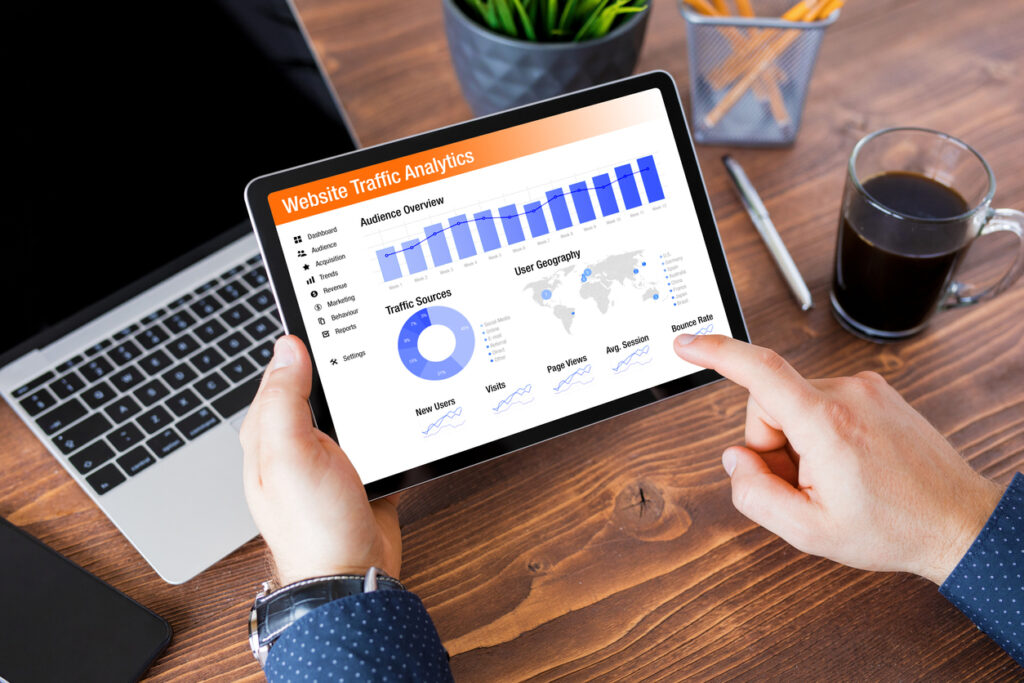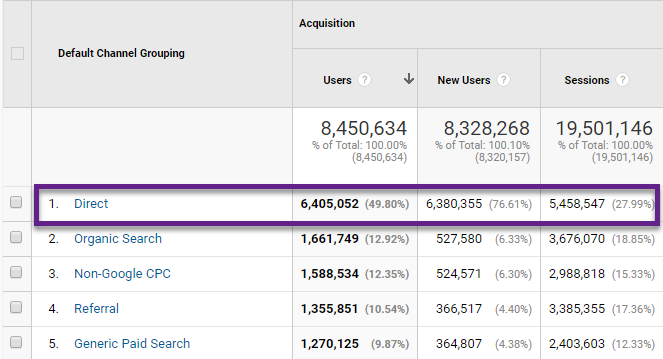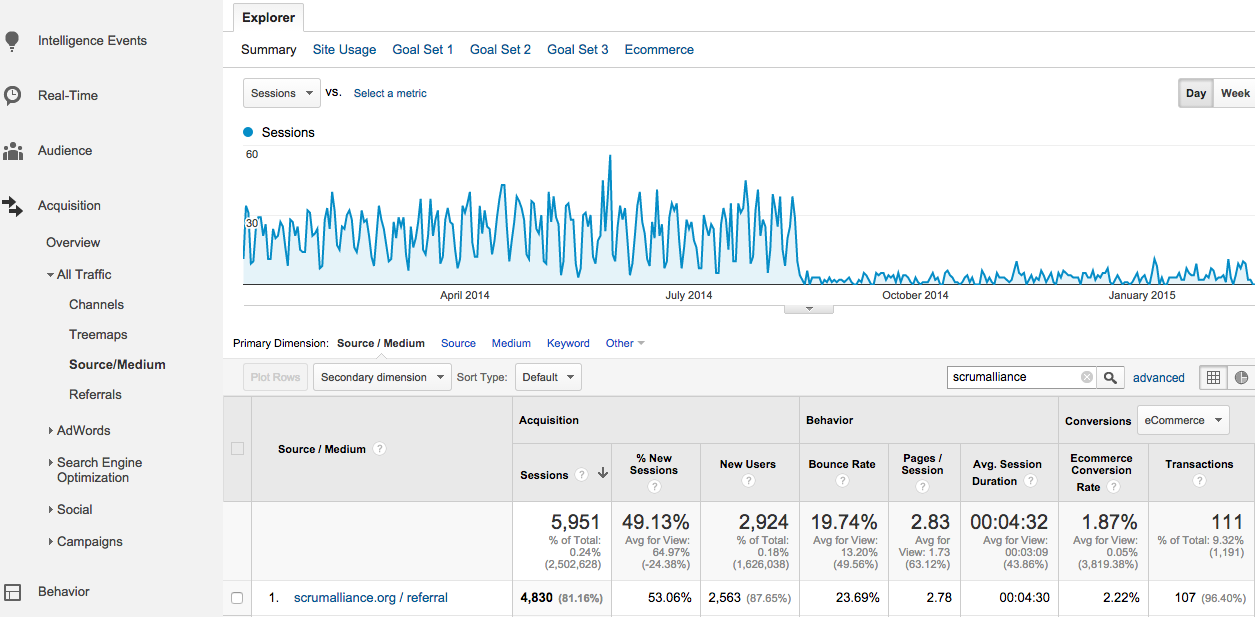What is Direct Traffic in Google Analytics
When monitoring the digital sphere, it becomes crucial to comprehend the various types of web traffic that come your way. An often misunderstood type is ‘direct traffic’. In the scope of google’s analytical tool, it has a distinct meaning and significance which is different from the general understanding of the term. This article delves into the specifics of direct traffic, as defined by Google Analytics.
Direct traffic, as simplistically understood, refers to the visitors that land on your website by typing your URL into their browser’s address bar or through a saved bookmark. This, however, isn’t a wholesome interpretation. In Google Analytics, the term carries a wider connotation, encompassing other untraceable traffic sources as well. Understanding this distinction becomes critical in diagnosing traffic changes on your website and formulating strategies for increasing web visibility.
This article aims to decode the concept of direct traffic and reveal its actual implication in Google Analytics. It will explore the reasons contributing to direct traffic influx, the effects it has on your overall data analysis, and the ways and methods of effectively managing direct traffic. The purpose is to provide insights, which can help marketers and web owners leverage this knowledge in optimizing their digital strategy and enhancing engagement.
The Concept of Direct Traffic in Google Analytics
When dealing with Google Analytics, many terms can be confusing, especially for beginners. One of these terms is Direct Traffic. Getting a firm understanding of direct traffic is critical as it forms a significant portion of website visits.
Essentially, direct traffic pertains to the visitors who arrive on your site by typing your URL into their browser or through bookmarks. These visitors come to your site directly, without being referred by another website or search engines. This route is often an indication of your branding efforts as it signifies that the audience is aware of your domain and visits it knowingly.
Key Points About Direct Traffic
The importance of direct traffic cannot be overstated. It has several characteristics that make it distinct. Some crucial aspects to keep in mind are:
- Often, direct traffic is an outcome of successful branding or repeat visitors. People who are already familiar with your site are likely to visit it directly.
- It is essential not to confuse direct traffic with organic search. While organic traffic comes from unpaid search engine results, direct traffic consists of visitors that already know your site’s address.
- Not all direct traffic is a result of actual users coming to your website. Some can be caused by bots crawling your site, so it’s crucial to discern between the two.
It is important to correctly interpret direct traffic data for your site’s successful optimization. Understanding the behavioral flow of direct visitors, their demographics, and interaction can lead to important insights. Hence, investing your time in comprehending the direct traffic data on Google Analytics can significantly impact the results of your digital strategies.
| Aspect | Description | Direct Traffic in Google Analytics | Benefits | Considerations |
|---|---|---|---|---|
| Direct Traffic Defined | Direct Traffic is a source/medium in Google Analytics that represents visitors who directly typed your website URL into the browser or used bookmarks to access the site. | – Source/Medium: “Direct / (none).” | – Clear distinction for tracking user entry. – Identifies users with prior knowledge or intent to visit your site. | – Definition based on user behavior for classification. – May not always capture all direct entries. |
| User Behavior | Direct Traffic signifies that users are familiar with the website URL and have a clear intent to visit, bypassing search engines or referral sources. | – Users directly access the website. | – Signals strong brand recognition. – Indicates user loyalty or prior interaction. | – Understanding user behavior and intent is crucial for accurate classification. – Variation in direct entry methods can occur. |
| Typical Scenarios | Direct Traffic often includes users who directly type the website address, use bookmarks, or have the URL saved. | – Direct entry via typing URL. – Use of bookmarks. – Access through saved links. | – Insights into user navigation habits. – Highlights the importance of brand visibility. | – Factors such as auto-complete or browser settings can influence direct entry. |
| Dark Traffic | Direct Traffic can sometimes include “Dark Traffic” when users access the site via apps or platforms that don’t provide referrer data, masking the true source. | – Some direct traffic may originate from “Dark Traffic.” | – Highlights the challenge of tracking accurate sources. – Indicates the need for improved tracking methods. | – Addressing “Dark Traffic” requires enhanced analytics and tagging methods. – May lead to incomplete source data. |
| Referral Exclusion | In some cases, referral exclusion is used to classify certain traffic as direct to prevent self-referrals. | – Implementation of referral exclusion settings. | – Eliminates self-referral issues in data. – Provides accurate source categorization. | – Careful configuration is required to avoid potential issues. – Self-referral prevention may not be needed in all cases. |
| User Intent | Understanding direct traffic helps identify users with clear intent or brand loyalty, offering insights into user behavior and marketing effectiveness. | – Assessment of user intent and familiarity with the website. | – User intent analysis for marketing optimization. – Strengthening brand visibility and recognition. | – Not all direct traffic may indicate high intent. – May require further segmentation for detailed analysis. |
Direct Traffic within the Framework of Google Analytics
In the realm of Google Analytics, direct traffic refers to the type of website visits where the path of the visitor to your webpage is not tracked by any referral source. It is an overview of the number of sessions that have no identified traffic source. This typically happens when a visitor either types your website URL directly into their browser’s address bar or accesses it via bookmarks. It is called “direct” because there is no intermediary between the visitor and the webpage.
The Importance and Challenges of Direct Traffic
- Meticulous Tracking: Direct traffic is a vital aspect of web analytics as it helps in monitoring the users who are already familiar with your platform. It provides an excellent avenue to measure brand recognition and loyalty amongst consumers. It becomes crucial for businesses to scrutinize this traffic to identify potential leads and loyal customers.
- Understanding User Behaviour: Direct traffic allows marketers to gauge user behavior in terms of repeated visits and session durations. It holds valuable data regarding user engagement and interest in the website’s content. Although, it must be noted that the user behavior for direct traffic might include multiple factors and not just brand loyalty or familiarity.
- Challenges: One of the primary challenges of direct traffic is that it can also include traffic that Google Analytics can’t identify the source of. For instance, secured HTTPS websites can be classified incorrectly as direct traffic. Plus, untagged email campaigns and visits from mobile apps might fall under the same category. This could create issues for businesses in deciphering accurate data.
The Impact of Direct Web Traffic on Performance Metrics
Among the numerous types of traffic sources, the influence that direct or immediate website traffic has on website performance metrics cannot be overstated. This kind of traffic is characterized by individuals who directly input your website’s URL into their internet browser or access it from their bookmarks, bypassing any form of search engine usage.
Complex as internet traffic can be, it’s important to understand how immediate visits affects the overall structure of your website performance indicators. By doing this, businesses and individuals can gain beneficial insights into user behavior and strategize their marketing efforts better.
The Significance of Direct Internet Traffic
Direct website visits play a pivotal role in assessing site performance. This metric helps in determining the number of users who are familiar with a brand or a website, to such an extent that they visit the website directly without the need to search online or click on referral links. Consequently, it is often seen as a gauge of brand power or customer loyalty.
Acknowledging User Experience and Engagement
The rates at which immediate traffic users visit can also expose aspects of user experience and engagement. High levels of repeat direct traffic can indicate a good user experience, as this suggests that users find the site useful, reliable and easy to navigate. This could result in them bookmarking it for future visits or remembering the URL.
An Overview of Traffic Composition
Another vital role that direct traffic plays is in understanding the composition of your website traffic. An unusually high proportion of direct traffic against organic or referral sources could indicate that your other marketing channels may not be performing optimally. This might call for a relook into your search engine optimization (SEO) strategies or your social media campaigns.
Direct Traffic and Conversion Rates
Direct traffic can greatly influence conversion rates as well. If a user is willing to directly enter your URL into their browser, chances are they already have a purpose in mind. This could be to make a purchase, fill out a form or perform other actions beneficial to your website. This often leads to high conversion rates as compared to other traffic sources.
Understanding Direct Traffic Categorization by Google Analytics
In the sphere of Google Analytics, an interesting category that often pops up is direct traffic. This primarily refers to the visitors that access your site by typing your URL into their browser, or those who visit your webpage through saved bookmarks. This category is one of the most fundamental segments of traffic and it’s imperative to comprehend how Google Analytics classifies it.
Direct traffic is a bit of a catch-all category. It includes all the users who directly enter the URL or tap on a bookmark to reach a certain website. However, it also goes beyond that. For instance, if Google Analytics can’t recognize the source of the traffic, it will be grouped into the direct traffic category as well.
Specific Scenarios of Direct Traffic Classification
Google Analytics uses several specific rules to classify direct traffic. Let’s delve deeper into a few of these scenarios:
- If a user clicks on a link from an email or a Microsoft Office document, Google Analytics might not be able to identify the source and will subsequently categorize it as direct traffic.
- If a user visits a website through a link on a mobile application or mobile message, Google Analytics will again possibly classify that as direct traffic due to inability to find the referring source.
- Lastly, if the user accesses a website via a secured (https) to non-secured (http) site, the referrer might get stripped off and hence Google Analytics will categorize it as direct traffic.
To conclude, it is significant to remember that direct traffic, as identified by Google Analytics, doesn’t solely constitute users directly typing a URL or accessing via bookmarks. It includes any scenario where Google Analytics can’t pinpoint the source of traffic. Therefore, understanding and working with direct traffic data needs a comprehensive understanding of these nuances.
The Impact of Straightforward Visitor Traffic Trends in Online Advertising Campaigns
Understanding one’s audience is a critical aspect of successful online marketing. Observing visitor traffic patterns such as “straightforward” or so-called “direct” traffic, analyzed through tools like Google’s data platform, is essential for this comprehension. This kind of traffic refers to visitors landing directly on your webpage without being redirected from an external source.
The data obtained from the analysis of straightforward visitor trends is significant for marketers as it delivers insights into the organic reach of the website. This reach could be due to brand recall and reputation, implying efficient branding efforts and high customer loyalty. It shows the level of awareness among customers about your brand and how frequently they visit your site directly.
Benefits of Accurately Assessing Straightforward Visitor Behaviour in Online Promotions
- Brand recognition: The proportion of straightforward traffic patterns can be an efficient gauge of brand recognition and recall. The more people who visit your site directly, the more likely it is that your brand has already established part of the consumer’s mindshare.
- User loyalty: Regular, direct visitors to your site are often loyal customers. These people recognise your brand and prefer your offerings over competitors. By considering this trend, businesses can identify and cater to their loyal customer base more efficiently.
- Unassisted conversions: Straightforward traffic trends help in understanding the unassisted conversions, that is, conversions that occur without any marketing push. It shows the users’ natural preference for your brand, which is vital for long-term growth.
Understanding the importance of straightforward traffic in Google’s website analytics tool is crucial in planning effective digital marketing strategies. These tools play an important role in decoding user behavior, assessing brand popularity, and in turn, driving valuable conversions.
Misunderstandings Related to Google Analytics Direct Traffic
Understanding Google Analytics can be a confusing task, especially when it comes to direct traffic concept. One of the most widespread misconceptions is that all untagged or untrackable traffic is direct. In essence, the term ‘direct traffic’ refers to visitors coming directly to your website without being redirected from another source. However, not all untagged visits fall into this category as sometimes, untagged traffic comes from sources like emails or social media which Google Analytics can’t recognize accurately.
Another common fallacy about direct traffic concerns the idea that it represents the number of users who directly type your website URL into their browsers. While these users do contribute to your direct traffic numbers, this category also includes users who access your website through bookmarks or untagged links from emails or other documents, and even some organic search traffic that the system wasn’t able to correctly identify.
Key Misconceptions in Summary
- Direct Traffic comes from untagged or untrackable traffic: Not all untagged visits are classified as direct traffic. It might also include visits from unrecognizable sources such as emails or social media.
- Users typing in the URL cause direct traffic: Yes, they contribute to your direct traffic, but other sources such as bookmarks, untagged emails or even improperly identified organic search traffic are also counted.
Interpreting data from Google Analytics requires an understanding of the diverse factors that influence each metric. While direct traffic may seem straightforward at first glance, it’s essential to keep in mind that it encompasses a range of visitor types and understanding its nuances can significantly improve your insights into your website’s performance.
Strategies for Boosting Direct Channel Visitors
In the realm of Google Analytics, visitors who arrive at your website by directly typing in your URL or having it bookmarked are known as direct channel visitors. This type of traffic displays a certain level of brand awareness and affinity as users do not require a search engine or another referral to reach your site. They already know the way to your digital haven. Consequently, boosting direct website traffic carries immense marketing significance.
However, increasing these high-quality traffic is no easy feat. It requires not only making your brand well-recognized and reliable but also ensuring that customers find your website valuable enough to revisit. Let’s explore some strategies to augment direct traffic effectively.
Strengthening Brand Awareness
For users to directly navigate to your website, they need to be aware of your brand and remember it. Enhanced brand exposure can be achieved through various methods such as offline advertising, digital advertising, and participating in events and industry forums.
- Offline advertising: Traditional advertising methods like TV advertisements, billboards, and newspaper adverts increase your brand exposure to a wider audience.
- Digital Advertising: Social media, display advertisements, and PPC campaigns help reach a broader and more targeted audience online.
- Industry Events and Forums: Sponsoring or participating in these can help establish industry authority and gain recognition.
Improve User Experience (UX)
It is significant to ensure that visitors find accessing and navigating your website easy and enjoyable. Optimizing your site for speed, ensuring mobile-friendliness, and making the design and navigation intuitive are all essentials to improve UX.
- Speed Optimization: Slow-loading websites can deter visitors and they may switch to faster alternatives.
- Mobile-friendly: With a large proportion of internet users on mobile, it’s imperative to make websites mobile-optimized.
- Intuitive design and navigation: A well-designed website is user-friendly, ensuring visitors find information they are searching for easily.
In conclusion, boosting direct traffic takes devoted efforts in strengthening brand recognition, awareness and optimizing user experience. Synergizing these strategies not only increases your direct traffic but also significantly improves overall website performance.
FAQ: Understanding What Direct Traffic Is in Google Analytics
What is direct traffic in Google Analytics?
Direct traffic consists of visitors who reach your website by typing the URL directly into their browser or using a bookmark. It’s considered one of the traffic sources.
How can direct traffic affect the accuracy of your traffic analysis?
An increase in direct traffic can obscure the true sources of your website’s traffic, making it challenging to analyze the effectiveness of your marketing efforts.
What is referral traffic, and how does it differ from direct traffic?
Referral traffic comes from visitors clicking on links to your website from other websites. It’s categorized separately from direct traffic in Google Analytics.
Which remarketing audiences can be defined in Google Analytics?
Which remarketing audiences can be defined in Google Analytics? You can create several types of audiences based on user behavior and engagement. For example, one audience can include users who visited specific product pages, while another can target users who abandoned their shopping carts. Understanding which remarketing audiences can be defined in Google Analytics is vital for effective marketing strategies. Additionally, you can segment audiences based on time spent on the site, pages viewed, or specific actions taken. Knowing which remarketing audiences can be defined in Google Analytics allows you to tailor your advertising efforts and improve overall campaign effectiveness. By effectively utilizing these audiences, businesses can maximize their remarketing efforts and drive higher conversion rates.
Why is it important to reduce direct traffic or understand its sources?
Reducing direct traffic can help you better attribute your website’s success to specific marketing channels and analyze the impact of your marketing campaigns.
What causes direct traffic to show up in analytics when it might not truly be “direct”?
Direct traffic can be attributed to various factors, including dark social traffic, incorrectly tagged links, or situations where the true source is not tracked accurately.
What steps can be taken to minimize the impact of direct traffic in analytics?
To minimize the impact, ensure your links are correctly tagged, use Google Analytics tracking code consistently, and consider using Google Tag Manager to manage your tracking.
How can Google Analytics differentiate between direct and other types of traffic sources?
Google Analytics uses the information available in the HTTP referrer to categorize incoming traffic. If there’s no referrer data, it’s often classified as direct.
What is remarketing in Google Analytics?
What is remarketing in Google Analytics? Remarketing in Google Analytics refers to the practice of targeting users who have previously visited your website. This allows businesses to re-engage these users with tailored ads as they browse other websites or use apps. To understand what is remarketing in Google Analytics, it’s important to set up remarketing tags and create specific audience lists based on user behavior. By doing so, you can effectively increase conversion rates and improve return on investment. In summary, what is remarketing in Google Analytics can be seen as a powerful strategy to reconnect with potential customers and drive them back to your site.
Dark social traffic is social sharing that isn’t easily traceable through normal analytics. It can contribute to direct traffic and is important to understand in a more comprehensive analysis.
Where can you find detailed reports on direct traffic in Google Analytics?
You can find information on direct traffic, including its sources, under “Acquisition” and “Channels” in your Google Analytics reports.
Why is understanding and accurately categorizing direct traffic essential for analyzing website performance and marketing campaigns?
It’s crucial for attributing success and optimizing marketing efforts. Accurate traffic source data helps you make informed decisions about your digital marketing strategy.
What is direct traffic, and how is it categorized in Google Analytics 4?
Direct traffic consists of visitors who directly type in your website URL or use bookmarks. In Google Analytics 4 (GA4), it is categorized as direct.
Why is it important to accurately categorize direct traffic and understand its sources in analytics data?
Accurate categorization of direct traffic helps attribute sources correctly, analyze marketing efforts, and optimize website performance.
What can lead to a sudden spike in direct traffic, and how does it affect analytics data?
A spike in direct traffic can result from sources like email marketing, offline advertising, or direct links shared on social media. It can obscure actual traffic sources in your analytics data.
What is the Google Analytics direct traffic definition?
What is the Google Analytics direct traffic definition? The Google Analytics direct traffic definition refers to the visitors who arrive at your website without a referral source. This means they typed your URL directly into the browser, used a bookmark, or clicked on a link in an email that doesn’t pass referral information. Understanding the Google Analytics direct traffic definition is crucial for accurately measuring the effectiveness of your marketing campaigns. By analyzing direct traffic, you can gain insights into brand awareness and user behavior. Therefore, when considering the Google Analytics direct traffic definition, it’s important to note that high levels of direct traffic can indicate a strong brand presence.
How is direct traffic reported in Universal Analytics compared to GA4?
Both Universal Analytics and GA4 categorize direct traffic in a similar way, but GA4 offers enhanced features for tracking and analyzing it.
Can direct traffic include bot visits, and how can this be managed?
Yes, direct traffic can include bot visits. Distinguishing between genuine users and bots is crucial for accurate analytics reporting.
How can email marketing contribute to direct traffic, and how can it be attributed in analytics?
Email marketing often generates direct traffic when users click links directly from email messages. Proper tracking and UTM parameters help attribute this source accurately.
What are some common reasons for high direct traffic on a website?
High direct traffic may result from strong brand recognition, extensive offline advertising, or inadequate tracking of other marketing channels.
What is Remarketing in Google Analytics?
What is remarketing Google Analytics? Remarketing in Google Analytics allows businesses to target users who have previously interacted with their website. This strategy is effective because it focuses on users who are already familiar with your brand. By utilizing remarketing analytics, businesses can track user behavior and create tailored ads that re-engage potential customers as they browse other sites. With remarketing with analytics, you can create specific audience segments based on criteria such as pages visited, time spent on the site, or actions taken, enabling more personalized advertising efforts. Understanding these concepts helps businesses maximize their advertising ROI by effectively reaching users who are more likely to convert.
Why is it important to accurately categorize traffic, particularly when dealing with “dark traffic”?
Accurate categorization ensures that “dark social traffic,” which is challenging to trace, is properly attributed and analyzed in your traffic reports.
What role do Google Ads play in generating direct traffic to a website?
Google Ads campaigns can sometimes lead to direct traffic when users click on ads that lead directly to your site. This should be tracked and analyzed.
How can you reduce unnecessary direct traffic and gain better insights into your website’s traffic sources?
Reducing direct traffic involves using Google Analytics code, tracking sources accurately, and optimizing marketing campaigns for better attribution.
© PhoenixProject, with full or partial copying of the material, a link to the source is required.





Comments: 0